From Mount Adams in the south to Mount Baker near the Canadian border, the summer of 2021 left its mark on Washington’s high country.
“For long-time residents of Washington state, it is jarring to see Mount Rainier without snow on its peak,” Rep. Marilyn Strickland said on the floor of the U.S. House of Representatives in September.
“In just four days this summer, four days in late June, the peak of the heat dome, the mountain lost 30% of its total snow cover,” she said, standing in front of before-and-after pictures of the state’s highest peak. “This is a visual demonstration that climate change is real.”
“I’ve lived here for the better part of 38 years, and I’ve never seen the mountains bare like they were this year,” Abby Yates of Everson said.

The summit of Washington's Mount Baker, 17 years apart: Aug. 29, 2004, (above) and Aug. 28, 2021 (below).
John Scurlock / KUOW
In Whatcom County, where Yates lives, the dominant feature of the horizon is the 10,781-foot snow cone of Mount Baker, the state’s third-highest peak.
“When I looked at the mountain and it was just gray, it honestly just made me want to cry,” Yates said. “I think I probably did cry.”
The big melt was just one toll of the Northwest’s extreme summer temperatures. The heat ruined crops and killed at least 138 people, thousands of salmon, and millions of shellfish in Washington state.
The big melt hit some people harder than others.
To Yates and other members of the Nooksack and Lummi tribes, the snows of Mount Baker aren’t just a backdrop: They’re a lifeblood.
This is part 1 of a 2-part series on the glaciers of Mount Baker.
The glacier-cloaked peaks of Mount Shuksan and Mount Baker in the North Cascades form the headwaters of the Nooksack River.
“Growing up, I knew the importance that not only Baker, but the glaciers and other snow runoff played for the Nooksack River,” Nooksack tribal member and planning manager Ross Cline Jr. said. “As a kid, I remember Mount Baker looking like it always had a huge pack of snow on it.”
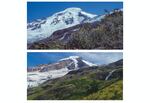
The north side of Washington's Mount Baker in August 1981 (above) and on Sept. 13, 2021 (below)
Alan Fritzberg / KUOW
Cline’s and Yates’s tribe has a profound connection to the river of the same name and the white-capped mountains that feed it.
“Where my family lives and has lived since time immemorial is so precious to me,” said Yates, whose backyard ends at a channel of the Nooksack River.
“When I have my feet in the water, that’s when I feel the most grounded,” she said. “Living near the water, being able to hear it every night when I fall asleep, it’s just a really important part of my life.”
One in four families on Nooksack lands lives in poverty. The median income is less than two-thirds that of Washington state, according to the U.S. Census Bureau.
Yates said she grew up very poor, with her parents fishing in the evening after working all day.
“So I understood from a very early age how important the river was to our family to provide food,” she said. “We ate a lot of salmon growing up.”
Like indigenous groups in much of the Northwest, the tribes of the Nooksack basin identify as salmon people.
“I’m Lummi. I’m one with the orca. I’m one with the salmon,” former Lummi tribal chair Jay Julius told a University of Washington class. “I don’t exist anymore without salmon, period. I am no more. I am a lost soul. I’m a lost spirit, and I don’t know how to put that into English words, either.”
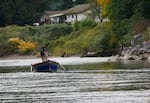
Salmon fishing on the Nooksack River in September 2021
John Ryan / KUOW
“I grew up eating salmon, sometimes three times a day,” Nooksack tribal chair Ross Cline Sr. said in an email. “This year I have had just one coho for the entire year. Over the years my diet has changed, resulting in health issues not known to my Nooksack ancestors.”
“We are losing our identity through our salmon,” said Lummi tribal council member Lisa Wilson. “The salmon is sick, and so are our people.”
The salmon of the Nooksack basin depend on the snows of Mount Baker.
“How do we keep the lands nourished if the rivers aren’t flowing?” Ross Cline Jr. asked. “How do we keep the salmon coming back if the water is too shallow and too warm for them to come back?”
To get at those questions, the Nooksack Tribe sends researchers up onto Mt. Baker every summer.
liver Grah was standing in a creek less than a foot deep, yet he couldn’t see his feet. The water was so thick with sediment that he might as well have been standing in chocolate milk.
“It’s cold!” said Grah, who manages water resources for the Nooksack Tribe. “It’s probably 32.5 degrees Fahrenheit.”
High on the slopes of Mount Baker, he and Whatcom Community College geologist Liza Kimberly were measuring the flow of Sholes Creek, one of the milky headwaters of the North Fork Nooksack River.
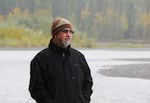
Nooksack Tribe planning manager Ross Cline Jr. in front of the Nooksack River
John Ryan / KUOW
Grah has been coming up here for 10 years to keep tabs on this glacier and the river its feeds. The frigid meltwater pours out of the snout of Mount Baker’s Sholes Glacier.
“To get a handle on how much of the glacier is melting each year, we do that by measuring streamflow coming out of the bottom of the glacier,” Grah said.
The Sholes is one of the easier glaciers to get to on Mount Baker, though that doesn’t mean it’s easy to get to. It’s a six-mile hike in, with the last mile an off-trail, ankle-twisting scramble.
As the glacier and nearby snowfields have retreated, a mile that once took 20 minutes to walk on hard-packed snow now takes an hour on loose, glacier-deposited rocks of every size.
At a half-dozen locations on top of the oozing river of ice, Grah and his crampon-sporting team measure the glacier’s response to a hot summer in a hot decade, following a century of gradual warming.
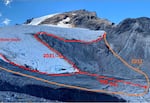
The Sholes Glacier on Mount Baker has retreated 400 feet since 2012.
John Ryan / KUOW
Whatcom County has warmed about 2.3 degrees Fahrenheit since 1922, according to the National Oceanic and Atmospheric Administration.
Mount Baker’s blankets of ice, which cover about 15 square miles around the volcano’s summit, are getting thinner and smaller. The nearly mile-long Sholes glacier has retreated up the mountain by more than 400 feet since Grah started studying it in 2012.
On top of the glacier, the changes can be imperceptible to the untrained eye. Underneath, it’s more obvious: Meltwater gushes off the glacier’s deep-blue underside.
Of course, glacier ice melts every summer. Fresh snow replenishes it in the winter. But as the climate has warmed, that annual dance has tilted in favor of melting, and glaciers around the world are melting away.
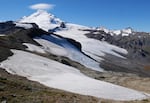
Nooksack Tribe glacier researchers cross a snowfield on their way to the Sholes Glacier on Mount Baker.
John Ryan / KUOW
The overall area of ice in the North Cascades has shrunk by more than half since 1900, according to Harriet Morgan with the University of Washington’s Climate Impacts Group, and the trend is accelerating.
From California to Canada, the exceptional summer of 2021 was rough on glaciers, with many losing at least 5% of their volume in a single summer, according to Nichols College glacier researcher Mauri Pelto. It was the worst or second-worst year (after 2015) for ice up and down the West Coast.
Pelto estimates Mount Baker lost 95 million cubic meters of ice in 2021, the equivalent of shaving at least 8 feet off every icy surface on the volcano.
“To offset that you would need at least 900 inches of snowfall, which is more than 50% above average,” Pelto said in an email. “Is that possible, yes. Is that likely, no.”
“The way things are going, it doesn’t look good for the atmosphere sustaining glaciers as we know it today,” Grah said.
Even while doing careful scientific measurements of something that is disappearing, emotions can come into play.
“It’s very sad,” Kimberly said. “The whole summit of Baker’s, like, brown rock right now.”
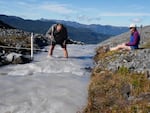
Oliver Grah and Liza Kimberly measure the flow of glacier-fed Sholes Creek on Mount Baker
John Ryan / KUOW
In August, Kimberly returned from Alaska, where she’d been studying the much larger glaciers of the Juneau Icefield.
“I literally started crying when I flew into Bellingham, just seeing these small alpine glaciers just disappearing,” Kimberly said. “I’ve never seen them so small, and it feels like they’re barely hanging on.”
Oliver Grah has also seen things this summer that he’s never seen before. On the long hike to the glacier, he noticed a small valley of bare rocks and dirt that until recently was a year-round snowfield.
“I’ve never seen no snow in that little basin before,” he said.
Until the summer of 2021, that patch of bare earth probably hadn’t seen the light of day in at least 700 years, according to Pelto.
f course, on a sunny day in September, with mountains all around, ptarmigans clucking, pikas peeping, tundra blueberries in their blaze-red fall colors, the high country of Mount Baker is still a place of breathtaking beauty.
It’s also a landscape of irretrievable loss.
“I don’t think we can do much that would change the rate at which the glaciers melt,” Grah said.
Humans could stop polluting the atmosphere—and prevent catastrophic losses to the human and natural worlds. But even that wouldn’t cool the climate enough to stop these glaciers from retreating any time soon.
As Mount Baker lives up less each summer to its Nooksack name Kweq’ Smánit (white mountain), the Nooksack Tribe is focused now on adapting: how to keep its cold-water-dependent way of life going in an overheated 21st century.
Coming Monday: Part 2 on the Nooksack Tribe’s efforts to keep a river, its salmon, and its people healthy in an ever-hotter world.
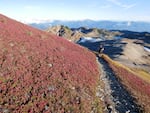
Fall colors on the tundra of the Ptarmigan Ridge trail in the Mount Baker Wilderness on on Sept. 23, 2021
John Ryan / KUOW